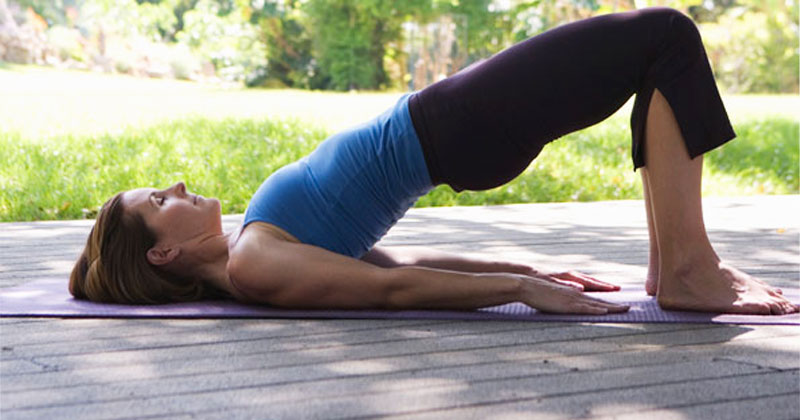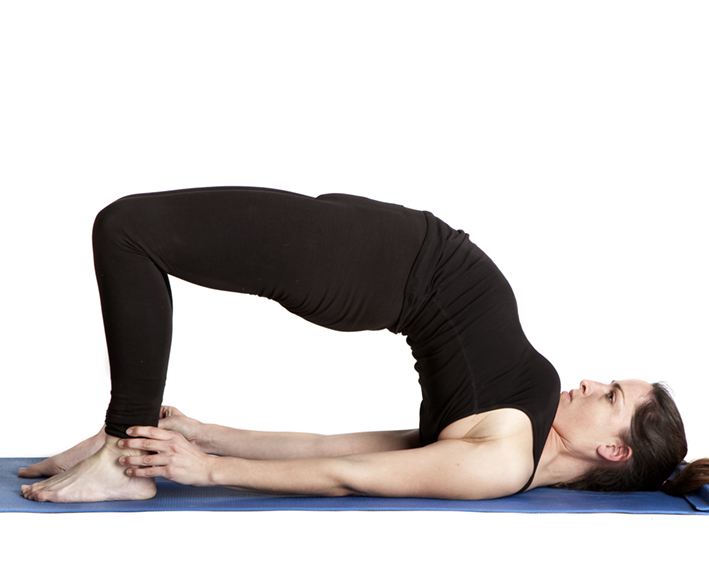
According to B.K.S. Iyengar “Backbends are rejuvenating. They give energy and courage and combat depression. They open the chest and make the spine flexible. The arms and shoulders become strong. The mind and body become alert.”
This posture is relatively simple and quite exhilarating.
How to do Bridge Pose Step by Step
- Lie on your back centered on your mat. Bend both knees and bring the feet up as close to your buttocks as possible. Place the feet on your mat hip width apart. Position your palms facing down aligned with your hips. Lie supine, facing the ceiling with an extended neck. The long extended neck that is best for Shoulderstand (Sarvangasana) should also be maintained in this pose.
Keep your feet parallel or slightly angled with the balls of the big toes closer to each other and the heels slightly more apart. As you raise your pelvis you may experience a tendency to reposition the feet to a different angle so that your big toes move away from each other and your heels move towards each other. Avoid this tendency and keep your feet planted firmly on the mat.
- Draw in your shoulder blades as you lift and push them away from the center of your body and down towards the mat. At the same time, firm up your thighs, knees and calf muscles, but keep your belly soft. Throw your head back, gently, and gaze either at the ceiling or, better still, at the wall behind.
- Keep stretching your legs forward and try to keep your feet flat on the floor. Initially, you may find yourself resting on your heels, but don’t let that bother you. Next time, resist the urge to rest on your heels and, right from the start walking your feet flat footed till they are stretched to the limit. Concentrate on the rise and fall of your belly as you continue to breathe normally.
- At first you may not be able to hold the pose for any more than 10 – 15 seconds. But, given the time, you will gradually be able to go up to one minute , even.
- To exit the pose, exhale deeply and gently take your elbows further apart and let your butt and back sink onto your mat. Then rest your neck and head and lie in Shavasana (Corpse Pose) for a few seconds, maybe even up to a minute, depending upon how long you held the pose. Never try this pose twice in consequence.

Benefits of Bridge Pose:
- Stretches the chest, neck, spine, and hips
- Strengthens the back, buttocks, and hamstrings
- Improves circulation of blood. Helps to prevent arterial blockages or cardiac arrest by resting the heart muscles and increasing blood circulation to the arteries.
- Helps alleviate stress and mild depression
- Calms the brain and central nervous system
- Stimulates the lungs, thyroid glands, and abdominal organs
- Improves digestion
- Helps relieve symptoms of menopause
- Reduces backache and headache
- Your 4th and 5th chakras open and move energy better after doing this posture.
- Reduces fatigue, anxiety, and insomnia
- Rejuvenates tired legs
- Relieves symptoms of asthma and high blood pressure
- Therapeutic for hypertension, osteoporosis, and sinusitis
Note:
- Check separation of knees and rolling the outer thighs as they are unhealthy movements. They can cause stress in the lower back. To counteract these unhealthy movements roll your inner upper legs down towards the floor and keep the upper legs parallel with each other throughout the pose.
- Do not allow your knees to “float” apart.
- The more you come onto the tops of the shoulders, the better the back arch you will be realize in the pose.
- The support of the weight of your body is on your two feet and two shoulders.
Contraindications/ Cautions:
- Do not do this pose if you have neck injury. Do not do this pose late in pregnancy.
- Do not do this pose with knee injury. A folded blanket or blankets would be useful if you have tight shoulders or neck in a way that you would use them in Halasana. Use them under guidance of a teacher. If you have back pain or injury, please consult your experienced teacher to teach you.
- Always listen to your body and stop if it hurts